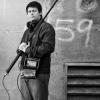Search the Community
Showing results for tags 'Technique'.
-
Hi All! Inspired by Rado's and Atheismystic's RM11/ COS technique threads, I have decided to post my own Tram-50 technique. My technique is similar to the turtle clip accessory offered by Tram, but offers a lower profile and the ability to customize/adapt the cage. It also avoids the vampire clips that come with the Tram mic cage. This technique isolates clothing from rubbing the mic capsules head. In addition, this techique allows the mic to act as a boundary microphone of sorts. I find this improves the tonal qualites of the mic and to my ears, makes the sound of the mic less honky. It also picks up the resonation of the chest well. And now, without further ado, lets start the tutorial! First I start with these items: Tram-50, Tram Tape Down accessory, a paper clip, wire cutters, hockey tape and a permanent marker (or something to shape the wire clip). I start first with the paper clip. I straighten out the clip as straight as possible. I then cut the paper clip with the wire cutters to be about 1&1/2 as long as the tape down accessory. I take the trimmed wire and bend it over a permanent marker to give the desired shape/curve to the wire. I press down on the wire and make sure I get a nice even curve to the wire while paying attention to the wire bending flat on the sides. This is achieved by using a flat surface such as a table. This is what the wire should look like at this point. As you can see, I have already taken the liberty of placing the Tram-50 into the tape down accessory, with the capsule facing DOWN. It is stated by Tram that the back side of the mic head is the least sensitive part of the microphone and thus, if clothing does somehow rub the mic head, it shouldn't be nearly as apparent as if it rubbed the front of the mic. Also, this allows the mic to act as a boundary microphone when placed on the chest. In the above photo, I line up the wire with the tape down accessory and insure that the bend in the wire will allow a small space for the mic . You do not want the wire touching the mic head, but instead just floating right above it. Next I trim the excess wire on both sides of the tape down so that there is no pointy ends sticking out of the tape down (ouch!). This is what it looks like. Now here is where the hockey tape (Eh?) comes into play. I use hockey tape because of its unique properties. It has superior adhesive, it's cloth/fabric like and is resistant to moisture. This results in the tape not coming undone (and in turn allowing the wire to not bend back and forth with ease), does not produce crunching/movement/rubbing sound like packing/generic tape and wont come undone due to sweating from talent. Perhaps athletic tape would suffice, but I have not tried it. I cut the hockey tape into 1/4" strips, about 2" long for a total of 2 strips. I place the wire flat ends about two thirds the way up on the Tape Down attachment and then place the hockey tape strips over the wire ends. This attaches the wire to the Tape Down attachment as shown below. With tension in the tape, I wrap both sides around the Tape Down attachment to not allow excessive movement in the wire. I wrap both sides about twice around. I press firmly on the tape over the wire. I want the wire ends to be firmly in place. I cut excess tape off the sides so that there are no sharp points of tape to rub against anything. This is what the finished product looks like. Notice the space allowed between the wire curve and the mic element/tape down accessory... I ussually tape down the attachment with surgical tape to the talents chest as such... Likewise, I can also attach to the talents shirt as such... Feel free to let me know if you all have any questions! Until then, Happy Tram'in! Paul Dorough Sound Art Film
- 34 replies
-
- Tram
- Lav techniques
-
(and 3 more)
Tagged with:
-
I've been a boom operator for only a couple of years, and I aim to continue doing this for some time. However, I am concerned about potential future back problems. I obviously stretch before shoots, excercise proper posture (no leaning) and have an extensive collection of muscle-soothing ointments. I was wondering if anyone could suggest techniques and equipment for taking the strain of operating off your mucles, as well as any excercises that may help to improve your necessary "booming" muscles. Cheers.
-
- 1 reply
-
- cables
- organizing
-
(and 1 more)
Tagged with:
-
I have a pet peeve when watching tv shows or film, and on an over the shoulder shot, you catch the shoulder actor's out of focus mouth moving up and down out of sync w/ their dialog. It's noticeable virtually every time and takes me out of the scene for a moment. When I record shots like this I like to keep the shoulder actors lav running to hopefully minimize this. How does anybody else feel about this?
-
Even when the wires sound well, when the actor looks down and they get much closer to the lav mic, I have yet to find a mixing technique that sounds transparent. I typically bring the level of the lav down but have been reluctant to bring up the level of 'air' from the boom to accomplish what my ears want to hear. I think this would do it, but...something stops me from pushing it far enough. Maybe just typing this will help get me there. Any thoughts?






